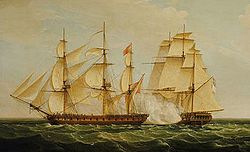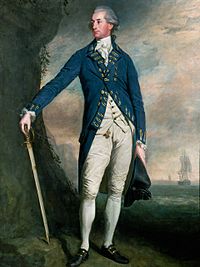Action of 14 September 1779 facts for kids
Quick facts for kids Action of 14 September 1779 |
|||||||
|---|---|---|---|---|---|---|---|
| Part of the American Revolutionary War | |||||||
 HMS Pearl, engaging the Spanish frigate Santa Monica off the Azores, 14th. September 1779; by Dominic Serres |
|||||||
|
|||||||
| Belligerents | |||||||
| Commanders and leaders | |||||||
| Strength | |||||||
| frigate Santa Mónica 26 guns |
frigate HMS Pearl 32 guns |
||||||
| Casualties and losses | |||||||
| 1 frigate captured 38 killed 45 wounded 180 captured |
12 killed 19 wounded |
||||||
The Action of 14 September 1779 was a small but important sea battle. It happened on September 14, 1779, near the Azores islands. This fight was between two frigates, which are fast warships. One was the British ship HMS Pearl, led by Captain George Montagu. The other was the Spanish ship Santa Mónica, led by Miguel de Nunes.
The Pearl won the battle, capturing the Santa Mónica. This event was part of the larger American Revolutionary War. In this war, American colonists were fighting for their freedom from British rule. Spain joined the war on the side of the Americans. Spain wanted to get back lands they had lost to Britain in an earlier war. These lands included Florida, Menorca, and Gibraltar.
British and Spanish navies often fought during this time. The conflict even spread to Europe. For example, Spain tried to capture Gibraltar from the British.
In September 1779, Captain George Montagu was sailing the HMS Pearl in the Atlantic Ocean. On September 14, he saw the Spanish frigate Santa Mónica. The Pearl chased the Spanish ship for two hours. Finally, the two ships met and began a fierce cannon battle.
Both ships were similar in size. However, the Spanish ship had fewer cannons. Also, many sailors on the Pearl had never been in a battle before. Captain Montagu was very skilled. He managed to move the Pearl to a position where it could fire along the length of the Santa Mónica twice. This caused a lot of damage. After this, the Spanish captain decided to give up. The captured Spanish ship was then taken to a British port.
Contents
Why the Battle Happened
After the Seven Years' War ended in 1763, Spain lost some important territories. They had to give Florida and Menorca to Britain. This was a big defeat for Spain. It made the Spanish King, Charles III, want to make his military stronger. He ordered a major reorganization of Spain's armed forces.
When the American Revolutionary War began, Spain saw a chance. They joined the Americans to get revenge on Britain. Spain started a long siege to try and take back Gibraltar. They also sent forces to recapture Florida and Menorca.
The British Royal Navy sent ships to the Atlantic Ocean. Their job was to resupply the British soldiers in Gibraltar. They also needed to make sure Britain controlled the seas. If Spain controlled the seas, they could easily capture Gibraltar. Gibraltar was seen as the "gateway to the Mediterranean".
Since July 1779, the Spanish Navy had been patrolling near the Azores. They were looking for British ships. A small group of Spanish warships was led by Lieutenant-general Don Antonio de Ulloa. This group included four large ships and two frigates. One of these frigates was the Santa Mónica.
The British commander, George Montagu, was young but experienced. He got his first command in 1771. In 1779, he was given command of HMS Pearl. On September 14, Montagu was sailing near the Azores. Early in the morning, he saw a large Spanish ship. He ordered his ship to chase it. After two hours, he caught up and realized it was a Spanish frigate. Both ships got ready for battle.
The Battle Begins

At 9:30 in the morning, the Pearl finally caught up with the Santa Mónica. Captain de Nunes of the Santa Mónica prepared his ship for a fight. He fired the first broadside, which is when all the cannons on one side of a ship fire at once.
The two ships were quite evenly matched. However, the Pearl was a very new ship. Only ten of its crew members had ever served on a warship before. The Santa Mónica also had fewer cannons than the British ship.
The battle lasted for some time. Both frigates suffered damage and had sailors injured or killed. The Pearl's crew, even though less experienced, managed to hit the Spanish ship much more. Captain Montagu skillfully moved his ship. He was able to fire along the length of the Santa Mónica not just once, but twice. This type of shot, called raking fire, causes huge damage. Captain de Nunes could not stop the Pearl from doing this.
After two hours of fighting, the Santa Mónica was badly damaged. Its sails and hull were hit hard. Thirty-eight of its men were killed, and forty-five were wounded. Captain de Nunes knew he could not win. He did not want to lose more of his men. So, he struck his colours, which means he lowered his ship's flag to show surrender.
Captain Montagu sent a small group of his men to take control of the Santa Mónica. Captain de Nunes gave his sword to Montagu as a sign of his surrender. The two frigates then sailed back to a British port. The weather was calm, so neither damaged ship sank. The Pearl had only minor damage, mostly to its rigging. It had lost twelve men killed and nineteen wounded. The surviving crew of the Pearl received prize money from the captured Spanish ship.
What Happened Next
The one hundred and eighty captured Spanish sailors became prisoners of war. They were later exchanged for British prisoners. This happened after a peace treaty was signed in 1802.
When the Spanish navy found out about the loss of the Santa Mónica, Lieutenant-general Ulloa faced a court martial. This was a military trial in Cádiz. He was tried for losing one of the ships under his command. However, he was found innocent and cleared of any blame.
The British carefully examined the Santa Mónica in port. It was a newly built ship, just like the Pearl. It had twenty-six cannons on its main deck and two smaller cannons on its quarterdeck. It had a crew of 271 men. The Santa Mónica was actually larger than the Pearl. This was an advantage the Spanish captain didn't manage to use during the battle. The British Navy decided to keep the Santa Mónica. They renamed it HMS Santa Monica. However, it did not see any more battles. It was wrecked off the coast of Tortola on April 1, 1782.
Captain Montagu continued to serve in the war. In December 1779, the Pearl joined a British group of ships. They helped capture a large Spanish convoy on January 8, 1780. The Pearl was damaged in that fight and sent home. Montagu also fought in the Battle of Cape Henry. This was his last battle before the war ended. He later served in another famous battle called the Glorious First of June.
Even though Britain won the siege of Gibraltar, they could not defeat the Americans. Britain eventually decided to end the war. They recognized the independence of the American colonies. The American Revolution had a huge impact on Europe. It helped lead to the French Revolution and later wars.
Order of Battle
| Ship | Commander | Navy | Guns | Casualties | |||||
|---|---|---|---|---|---|---|---|---|---|
| Killed | Wounded | Total | |||||||
| HMS Pearl | George Montagu | 32 | 12 | 19 | 31 | ||||
| Santa Mónica (captured) | Miguel de Nunes (POW) | 28 | 38 | 45 | 83 | ||||
Images for kids
-
A portrait of the British commander, George Montagu, by Thomas Beach.
-
HMS Pearl and the Santa Monica, 14 September 1779, by Thomas Whitcombe.
See also
 In Spanish: Acción del 14 de septiembre de 1779 para niños
In Spanish: Acción del 14 de septiembre de 1779 para niños





